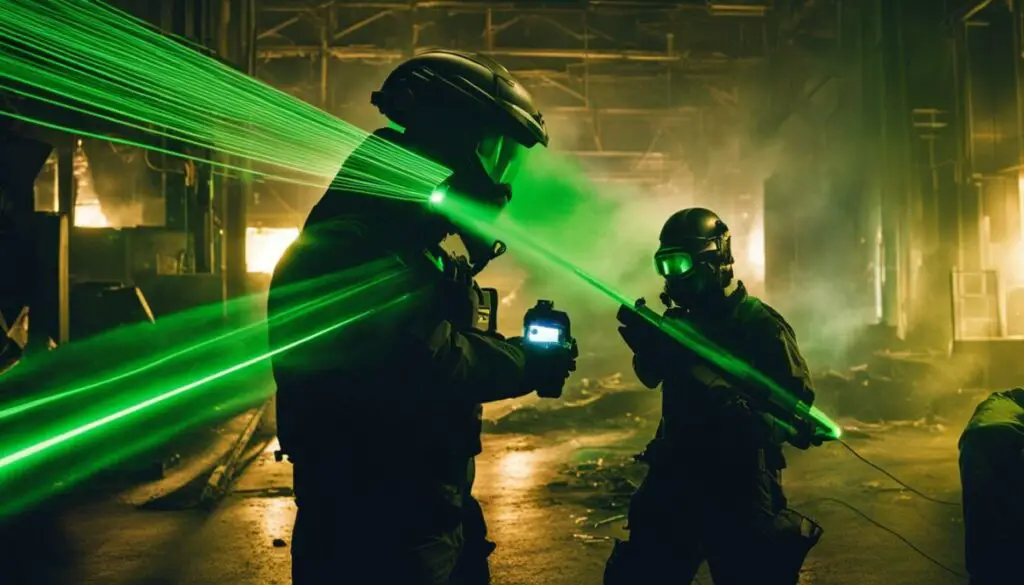Last Updated on 5 months by Francis
Are you curious about the legality of infrared lasers? In this article, we will delve into the legal status of infrared lasers, the laws and regulations surrounding their use, and the potential risks involved. Whether you’re a laser enthusiast or simply want to understand the regulations better, this article aims to provide you with the information you need.
Contents
Key Takeaways:
- Understanding the legality of infrared lasers is essential to avoid legal and civil penalties.
- While it is generally legal to purchase infrared lasers in the United States, specific licensing and training requirements exist in five states.
- Strict safety regulations are in place to ensure the responsible use of infrared lasers, as the potential damage to eyesight can be significant.
- Green lasers, which have various applications, are subject to their own set of regulations and restrictions.
- Prioritizing safety measures, such as wearing appropriate eye protection, is crucial when using lasers to minimize potential harm.
The Dangers of Infrared Lasers
Infrared lasers can pose serious dangers if not used properly. The intense light emitted by these lasers can cause retinal burns, leading to permanent damage to the eyesight. Even brief exposure to a high-powered infrared laser can result in significant eye injuries. It is crucial to prioritize eye safety and take all necessary precautions when using infrared lasers to avoid potential harm.
Exposure to infrared laser radiation can cause thermal damage to the eye’s sensitive structures, including the retina. The retina is responsible for translating light into visual signals that our brain can interpret. When the retina is damaged, it can lead to partial or complete vision loss. The effects of infrared laser exposure can be immediate or may develop gradually over time.
To minimize the risks associated with infrared lasers, it is important to wear appropriate laser safety goggles. These goggles are designed to filter out the specific wavelength of the laser being used, protecting the eyes from harmful radiation. Additionally, it is essential to follow proper laser handling procedures and avoid pointing lasers at reflective surfaces.
| Eye Safety Tips for Using Infrared Lasers |
|---|
| Always wear laser safety goggles that are appropriate for the wavelength of the laser being used. |
| Avoid aiming infrared lasers at reflective surfaces to prevent accidental exposure. |
| Do not direct the laser at other people, animals, or aircraft, as this can cause serious harm. |
| Ensure that the laser is used in a controlled environment, away from distractions and potential hazards. |
| Remember that even low-powered infrared lasers can pose risks, so always exercise caution when using them. |
“The misuse of infrared lasers can lead to irreversible damage to the eyesight. It is crucial to understand and respect the potential harm they can cause. Prioritizing eye safety and following proper handling procedures can help mitigate the risks associated with infrared lasers.” – Dr. Jane Stevens, Ophthalmologist
Regulatory Measures for Infrared Lasers

Infrared lasers, like any other laser technology, are subject to regulatory measures to ensure their safe and responsible use. Governments around the world have implemented specific regulations and legal measures to control the possession and operation of these lasers. Understanding and adhering to these regulations is crucial to avoid legal consequences and ensure the safe handling of infrared lasers.
Government Regulations on Infrared Lasers
Government regulations on infrared lasers vary from country to country. In the United States, for example, while it is generally legal to own and use infrared lasers, certain states have imposed specific restrictions and licensing requirements. It is important to familiarize oneself with the specific regulations in your country or state to ensure compliance.
These regulations are in place to prevent the misuse of infrared lasers, which can cause harm to individuals and property. Violating these regulations can result in severe legal penalties and civil liabilities due to the potential damage that infrared lasers can cause to a person’s eyesight.
It is essential for individuals to have a thorough understanding of the regulations and safety precautions associated with infrared lasers before using them. This includes obtaining the necessary licenses or authorizations, complying with safety guidelines, and being aware of any restricted areas or prohibited uses of these lasers.
| Country | Regulatory Measures |
|---|---|
| United States | Specific restrictions and licensing requirements in some states |
| Canada | Possession and use without proper authorization is illegal |
| European Union | Restrictions on possession and use of certain classes of lasers |
By complying with the government regulations and understanding the legal measures associated with infrared lasers, individuals can ensure both their own safety and the safety of those around them.
“Government regulations on infrared lasers are crucial to prevent misuse and ensure the safe handling of these powerful devices.” – Laser Safety Council
The Use of Green Lasers

Green lasers have become increasingly popular for various applications, including astronomy and military targeting. These lasers emit a green light that is highly visible and can be used for long-distance pointing and aligning purposes. The unique characteristics of green lasers make them a preferred choice in certain industries. However, the legality of green lasers varies from country to country, and it is important to understand the regulations surrounding their use.
In many countries, including Canada, the possession and use of green lasers are strictly regulated. Special licenses are required to possess and operate green lasers due to their potential hazards. These regulations are in place to protect individuals and prevent misuse that could result in harm or safety risks. It is crucial to familiarize yourself with the specific laws and regulations governing green lasers in your jurisdiction to avoid legal consequences.
Despite the regulations, there are legitimate uses for green lasers in various industries. For example, in astronomy, green lasers are used to point out celestial objects during stargazing activities or to align telescopes. In the military, green lasers are utilized for long-range aiming and target designation. These applications demonstrate the practical and beneficial uses of green lasers when used responsibly and in accordance with the law.
To summarize, the use of green lasers is subject to specific regulations and licensing requirements. Understanding and adhering to these laws are essential to ensure compliance and prevent legal repercussions. With proper knowledge and responsible use, green lasers can continue to be valuable tools in industries such as astronomy and military targeting while minimizing the risks associated with their use.
Table: Comparison of Green Laser Regulations
| Country | Regulations | Restrictions |
|---|---|---|
| United States | Regulated by federal laws | Restrictions on laser output power, prohibited use near airports |
| Canada | Strict regulations requiring licenses | Prohibited possession without a license |
| United Kingdom | Controlled by laser safety regulations | Restrictions on laser output power, prohibited use near airports |
| Australia | Regulated by state and federal laws | Restricted sale, prohibited use near airports |
The Hazards of Green Lasers

Green lasers, when misused, can pose significant hazards and safety concerns. Due to their high power output and visibility, these lasers can cause temporary or permanent blindness if aimed directly at the eyes. The intense light emitted by green lasers can cause retinal burns and other severe eye injuries, leading to long-term vision impairment. It is crucial to exercise caution and take necessary precautions when using green lasers to avoid potential harm.
Another safety concern with green lasers is their potential to emit infrared radiation. When exposed to direct sunlight, green lasers that emit infrared radiation can harm the retina and cause damage to the eyes. It is important to be aware of this risk and avoid using green lasers in bright outdoor settings to minimize the potential harm they can cause.
“The high power output and visibility of green lasers make them highly hazardous when used irresponsibly. Direct exposure of the eyes to a green laser beam can result in permanent eye damage, including blindness. It is crucial to prioritize safety and follow proper laser operation procedures to prevent accidents and protect your vision.”
To ensure the safe use of green lasers, it is essential to follow recommended safety guidelines, including wearing appropriate eye protection. Laser-protective eyewear designed for specific laser wavelengths can help reduce the risk of eye injuries when using green lasers. Additionally, it is important to avoid aiming green lasers at reflective surfaces, as this can cause dangerous reflections and increase the risk of accidental exposure to laser beams.
Laser Pointer Safety Regulations

When it comes to laser pointer safety, there are important regulations that individuals need to be aware of. The misuse of laser pointers can have serious consequences, including posing a safety risk to individuals and potentially causing harm. It is essential to understand and follow these regulations to ensure the safe use of laser pointers.
Regulations for Laser Pointers
One key regulation is the prohibition of aiming laser pointer beams at aircraft or their flight paths. This is a crucial safety measure to avoid distractions for pilots and prevent potential accidents. In the United States, aiming a laser pointer at an aircraft is not only illegal but can also result in criminal charges and substantial penalties.
“Aiming lasers at aircraft is a federal crime and poses a serious threat to aviation safety. It can cause temporary blindness, flash blindness, and even permanent eye damage to pilots, endangering the lives of all on board.” – Federal Aviation Administration (FAA)
Many states have enacted additional laws to regulate laser pointer use. Some states require the registration of certain classes of lasers, while others prohibit aiming lasers at law enforcement officers or imposing strict penalties for laser misuse. It is crucial to familiarize yourself with the specific regulations in your jurisdiction to ensure compliance and prevent accidents.
Safety Measures for Laser Pointer Use
In addition to following regulations, there are safety measures individuals should take when using laser pointers. One essential precaution is to avoid pointing the laser at reflective surfaces or directly into someone’s eyes. This can help prevent accidental exposure and potential injuries. Furthermore, it is important to handle laser pointers responsibly and keep them out of the reach of children to avoid misuse.
By understanding and adhering to laser pointer safety regulations and implementing necessary safety measures, individuals can enjoy the benefits of laser pointers while prioritizing the well-being and safety of themselves and others.
Laser Safety Measures

When using lasers, it is essential to prioritize safety and take appropriate precautions to protect yourself and others. Here are some important laser safety measures to consider:
1. Eye Protection:
Wearing appropriate eye protection is crucial when using lasers. Laser-protective eyewear designed for specific laser wavelengths can help reduce the risk of eye injuries. It is important to choose eyewear that is suitable for the laser you are using and meets the required safety standards.
2. Follow Operation Procedures:
Properly following laser operation procedures is essential to minimize the risks associated with laser use. This includes avoiding aiming lasers at reflective surfaces, as it can cause hazardous reflections or unintended exposure. It is also important to ensure that the laser beam is properly aligned and controlled to prevent accidental exposure.
3. Control Access and Secure Lasers:
Keep lasers in a secure location and restrict access to authorized personnel only. This helps prevent unauthorized use and potential accidents. It is also important to regularly inspect and maintain lasers to ensure they are in proper working condition and comply with safety standards.
By implementing these laser safety measures, you can significantly reduce the risk of accidents and protect yourself and others from potential harm. Remember to always prioritize safety and stay informed about the latest safety guidelines and regulations regarding laser use.
International Regulatory Response

The use of lasers is subject to international regulations aimed at ensuring safety and minimizing potential harm. Countries worldwide have implemented measures to regulate the possession, use, and import/export of lasers. These regulations vary in scope and stringency, but they all share the goal of protecting individuals and preventing misuse.
One example of international laser regulations is the International Electrotechnical Commission’s standard IEC 60825, which provides guidelines for the safety of laser products. This standard classifies lasers into different hazard classes based on their potential risks and sets safety requirements for manufacturers and users.
“International laser regulations aim to protect individuals from the potential dangers of lasers and prevent their misuse. These regulations help ensure that laser products meet safety standards and are used responsibly.”
In addition to these global standards, many countries have their own specific regulations and requirements for laser use. For instance, the European Union has implemented regulations that restrict the use of laser pointers to certain classes of lasers, prioritizing safety and minimizing the risks associated with their misuse.
| Country | Regulatory Response |
|---|---|
| United States | The United States has federal regulations regarding laser ownership, but it generally allows the possession and use of infrared lasers. However, specific restrictions and licensing requirements vary by state. |
| Australia | Australia has issued advisory circulars for lasers and aircraft, providing guidelines for protecting pilots from accidental laser beam strikes. They have strict regulations in place to ensure the responsible use of lasers. |
| Canada | Canada has specific criminal code provisions related to aiming lasers at aircraft. Possessing and using lasers without proper authorization is strictly regulated, and special licenses are required for their use. |
These international and country-specific regulations aim to strike a balance between allowing for the beneficial use of lasers in various fields while ensuring the safety of individuals and preventing their misuse. It is essential for individuals using lasers to familiarize themselves with the specific regulations in their jurisdiction to ensure compliance and avoid legal consequences.
Consequences of Laser Misuse
Using lasers inappropriately or illegally can have severe consequences, both legally and in terms of public safety. The repercussions of laser misuse can range from criminal charges and significant penalties to lasting harm to individuals and property. It is crucial to understand and respect the regulations surrounding laser use to avoid these negative outcomes.
In many countries, including the United States, pointing lasers at aircraft or their flight paths is a criminal offense. Those found guilty of such actions can face severe legal penalties, including hefty fines and even imprisonment. The seriousness of these penalties reflects the potential danger posed by laser beams to pilots’ vision, which can lead to catastrophic accidents during flight.
“Misusing lasers, such as aiming them at aircraft or engaging in illegal activities, can have severe consequences. In the United States, individuals who point lasers at aircraft or their flight paths can face criminal charges, including significant penalties and life imprisonment.”
The repercussions of laser misuse extend beyond legal consequences. Improper use of lasers can cause permanent eye damage, including blindness. Even a brief exposure to a high-powered laser beam can result in severe eye injuries. Additionally, lasers can pose a fire hazard if used recklessly, potentially causing property damage or endangering lives.
It is essential to educate individuals about the potential risks and legal ramifications of laser misuse. By promoting awareness and responsible laser use, we can help prevent accidents, protect public safety, and ensure the continued enjoyment and benefits of laser technology.
Conclusion
Infrared lasers and green lasers are powerful tools that have various applications in fields such as astronomy, military targeting, and research. While the legality and regulations surrounding their use may differ from country to country, it is crucial to have a thorough understanding of the laws and adhere to them to avoid legal consequences.
When using lasers, especially high-powered ones like infrared and green lasers, prioritizing safety measures is of utmost importance. Wearing appropriate eye protection and following proper laser operation procedures can help mitigate the risks associated with laser use and protect against potential harm.
By understanding and respecting the regulations, individuals can safely harness the benefits of laser technology while minimizing the potential for accidents or injuries. It is essential to stay informed about the specific laws and regulations in your jurisdiction to ensure compliance and promote the responsible use of lasers.
FAQ
Are infrared lasers legal?
In the United States, it is generally legal to purchase infrared lasers, with the exception of five states that have specific licensing and training requirements. However, it is essential to have a thorough understanding of the regulations and safety precautions before using infrared lasers.
What are the dangers of infrared lasers?
Infrared lasers can cause retinal burns and permanent damage to the eyesight. Even minor exposure to a high-powered infrared laser can result in significant eye injuries.
What are the regulatory measures for infrared lasers?
In the United States, there are federal regulations regarding laser ownership, but there are specific restrictions and licensing requirements in various states.
Is the use of green lasers legal?
The use of green lasers is not allowed in all countries, including Canada. Possessing and using green lasers without proper authorization is illegal.
What are the hazards of green lasers?
Green lasers can cause temporary or permanent blindness if aimed directly at the eyes. They can also be harmful to the retina if exposed to direct sunlight.
What are the laser pointer safety regulations?
Laser pointer beams should not be aimed at aircraft or their flight path, as it is illegal and poses a significant safety risk. Many states have additional laws to regulate laser pointer use, including prohibitions on aiming lasers at aircraft.
What are the laser safety measures?
It is crucial to wear appropriate eye protection when handling high-powered lasers and to follow proper laser operation procedures to minimize the risk of eye injuries and accidental exposure to laser beams.
How have countries responded to laser regulations?
Many countries have implemented restrictions and regulations on lasers, including the European Union, Australia, and Canada. It is important to be aware of the international regulations regarding lasers.
What are the consequences of laser misuse?
Misusing lasers, such as aiming them at aircraft or engaging in illegal activities, can result in severe legal penalties, including significant fines and imprisonment.
What is the conclusion regarding laser legality?
It is crucial to understand and adhere to the regulations surrounding the possession and use of lasers to avoid legal consequences and ensure safe use.
Source Links
- https://www.photonics.com/Articles/Regulations_Aim_at_Illegal_Laser_Activity/a57779
- https://www.eevblog.com/forum/reviews/are-ir-lasers-really-illegal-for-companies-to-sell-to-non-government-entities/
- https://www.leicestershirevillages.com/exploring-the-regulations-and-consequences-of-green-laser-use-in-canada/





.jpg)



